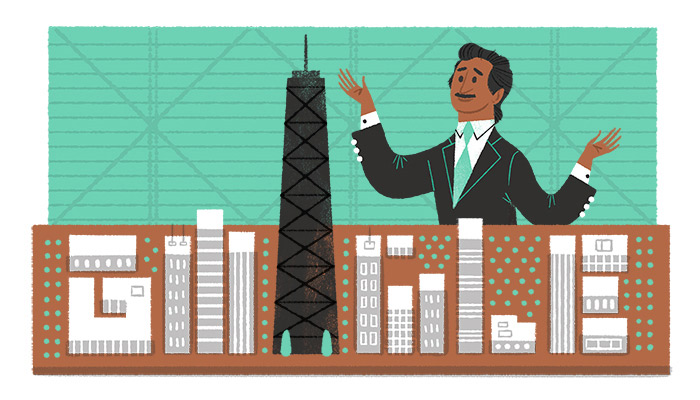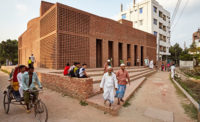Google has released a Doodle today to honor what would have been Fazlur Rahman Khan’s 88th birthday—a structural engineer who revolutionized skyscraper design.
The Doodle, designed by artist Lydia Nichols, depicts the Bangladeshi-American engineer next to the John Hancock Center in Chicago, which he designed at SOM in the 1960s.
The engineer was born in present-day Bangladesh in 1929 and received his engineering degree at the University of Dhaka. While on a Fulbright Scholarship, he enrolled at the University of Illinois at Urbana Champaign. There, he achieved two master’s degrees as well as a PHD in structural engineering. He then embarked on a successful career at SOM in Chicago beginning in 1955.
Khan pioneered the tube system, which placed a building’s structure on its exterior, much like a hollow tube. Because of its ability to resist lateral forces such as wind and seismic activity, this revolutionary strategy allowed buildings to reach new heights. At the same time, it cut costs and maximized useable floor space by reducing interior columns.
While at SOM he went on to design Chicago’s Willis Tower (formerly known as the Sears Tower), One Shell Plaza in Houston, and King Abdulaziz International Airport in Saudi Arabia. His Hancock Center in Chicago featured x-braces, another variation on his tubular system.
Khan was also an early adopter in CAD, and convinced his bosses at SOM to buy the firm’s first computer in the 1970s.
In 1972, Engineering News-Record (RECORD’s sister publication) named him Construction’s Man of the Year.
He told ENR at the time, “When thinking design, I put myself in the place of a whole building, feeling every part. In my mind I visualize the stresses and twisting a building undergoes.”
According to Khan’s daughter, the engineer also empathized with the people who would use his buildings. Said Yasmin Sabina Khan, in Google’s announcement, “A humanitarian in his personal as well as professional life, he was inspired by the belief that his work had a positive impact and he encouraged other engineers not to lose track of the purpose of their profession.”



